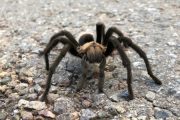My wife Louise and I left our gite in Lison, not far from the sites of the D-Day beach landings in Normandy, on a fog-shrouded early morning in October 2011 for our rendez-vous later that day with Laurent Viton. We made a brief stop at the basilica devoted to Ste. Therese in Lisieux, and made a side-trip to the somnolent hamlet of Repentigny in the pleasantly green Dorette River valley, from which Louise’s ancestors came to Canada in the seventeenth century. We arrived in Goderville at noon to meet Laurent. He is a postman and married father of two, with a passionate interest in flight. Unable to fulfil a childhood dream to fly, and fascinated by stories of aerial combat, he has made himself an authority on all aspects of the aerial war over his corner of Normandy between 1940 and the end of the war in 1945. He had been in touch with historians, with veterans’ organizations in Britain and Canada, with the relatives of downed pilots, and up until recently, with some of the surviving elderly pilots themselves, then in their seventies and eighties. He had been involved the month before our arrival with a BBC film crew then making a television program with Dan Snow, its presenter, who is related to the Canadian academic Margaret MacMillan, on the recent discovery of a downed Spitfire piloted by 22-year-old Canadian Harold Heninger of Calgary, who had been killed in 1944 when his parachute got caught on the tail of his aircraft as it plunged to the ground near Rouen.
We followed Laurent in his Renault Kangoo van to the corner of a sloping field that we had come to inspect, just beyond Ecrainville, a short distance from Goderville. We walked across rutted farmland in Laurent’s footsteps. It was undeniably, but incredibly, the same field into which a Royal Air Force Hawker Typhoon pilot of 257 (Burma) Squadron had made a forced landing on January 29, 1944. We stood where it had come to rest. In the distance across the field were the same buildings as those in the photograph taken by German soldiers shortly after they took possession of the crippled aircraft on its belly in the field, its propeller bent back from its awkward landing, its fuselage markings identifying it as JP 491. This photo, found by a Canadian soldier raiding a Luftwaffe base in the wake of the D-Day landings, was forwarded to a veteran pilots’ association in Canada, and eventually found its way to our family almost 50 years after it was taken. Behind us, the same distinctive brick-and-stone barn at least a century old stood next to the identical two-storey wooden building in the photo, itself adjoining a copse, both still there today. Without these landmarks, no-one would have been able to locate the site. With a schoolboy’s enthusiasm, Laurent pointed to a nearby field where yet another Typhoon had come down on the very same day. He led us back to the cars, and we followed in our rented Peugeot to look at a big house not far from the field where Laurent assured us the pilot of the first Typhoon had asked the lady of the house to burn his uniform, unwilling as he was to fall into German hands in what was then Occupied France. Our gaze was interrupted by the arrival of its owner, a blonde behind the wheel of a BMW who eyed us suspiciously as we drove away. It seemed unlikely that she would have been interested to know that the pilot who had preceded us there 67 years earlier was my late father, Flight-Lieutenant Peter G. Scotchmer, after whom I am named.

Photograph of my dad standing beside the damaged Typhoon aircraft he flew.





Andrew Halpenny5 years ago
This is a wonderful, personal account of war. No remembered heroes, except to those they touched and loved. It is a very human story, and that is the essence of what we should remember of war.
Susan Leadlay3 years ago
I have just read this story, Peter, and found it very moving. It certainly paints a picture of the horrors of war, the inhumane treatment that some people can show to others, and, the complete opposite, too, the wonderful kindness and bravery of those who are prepared to help others, even in the face of the risk to themselves. I feel so strongly all that your father endured during his time of freedom, of imprisonment and during his long march. So awful.
How sad that you didn’t learn of the connection to your colleague at SRB, till it was too late. Such is life, though.